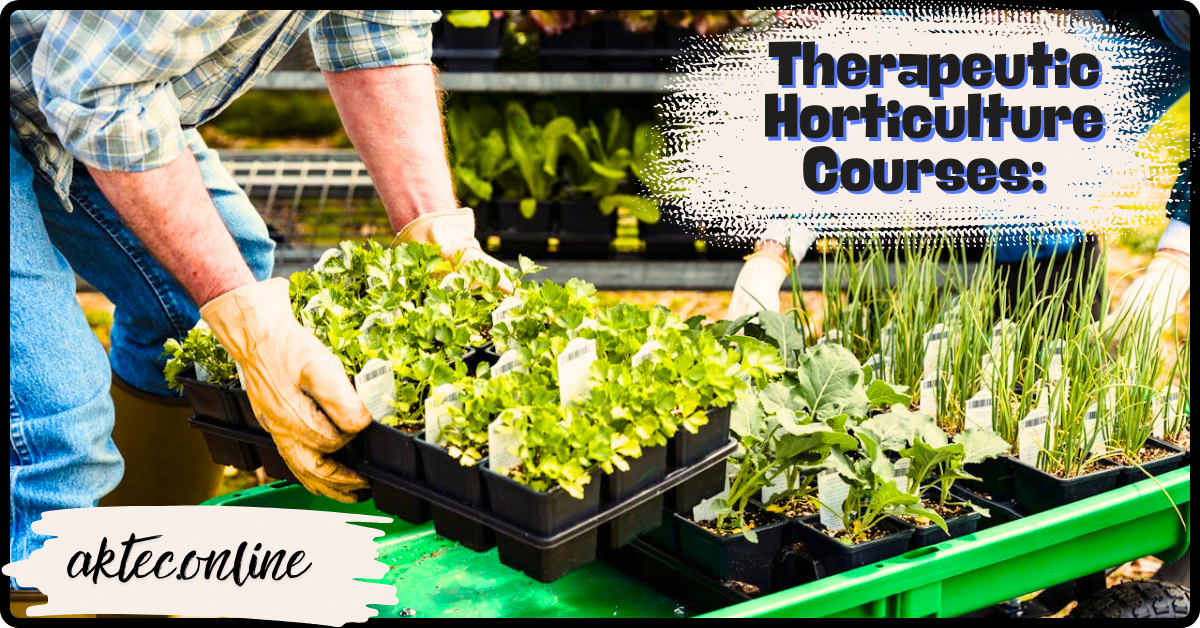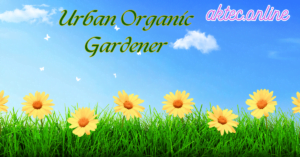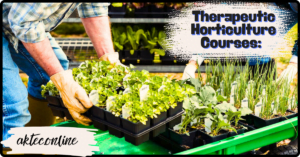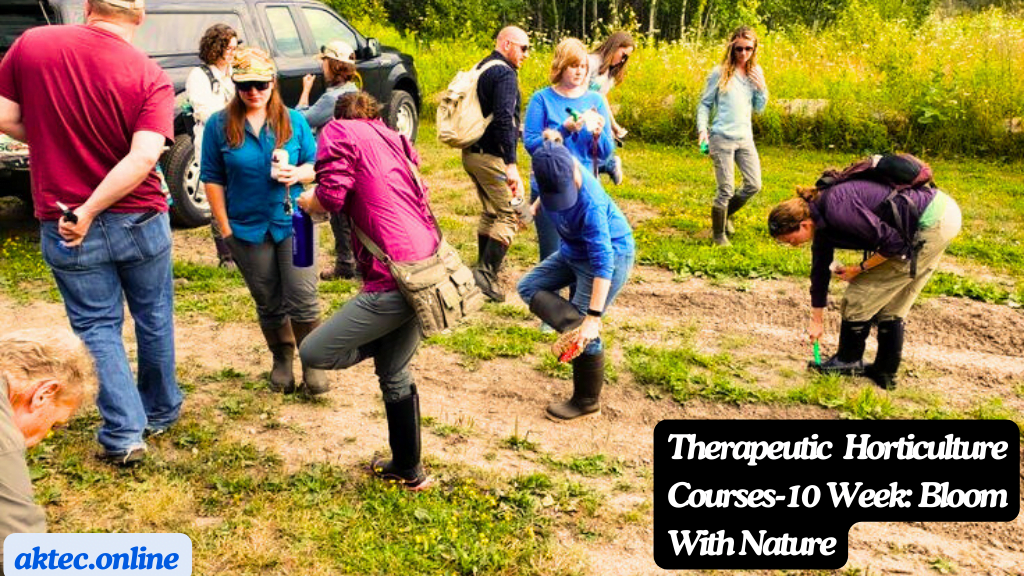
Unleash the healing power of plants. Explore accredited therapeutic horticulture courses and cultivate wellbeing for yourself and others.
Therapeutic Horticulture Courses Introduction
What is Therapeutic Horticulture Courses ?
Therapeutic horticulture courses is a holistic practice that utilizes plants and gardening activities to improve the physical, mental, and social well-being of individuals. It caters to people of all ages and backgrounds and can be implemented in various settings like hospitals, rehabilitation centers, schools, and correctional facilities.
Benefits of Therapeutic Horticulture Courses for Mental and Physical Health
Research has shown that therapeutic horticulture Courses offers a wide range of health benefits, including:
Reduced stress and anxiety
Improved mood and overall well-being
Enhanced self-esteem and confidence
Development of fine motor skills and coordination
Stimulation of senses and cognitive function
Encouragement of socialization and social interaction
The Core Principles of Therapeutic Horticulture courses
Therapeutic horticulture is built upon several fundamental principles:
Individualized Programs
Gardening activities should be tailored to the specific needs and abilities of each participant.
Active Engagement
Participants are encouraged to actively participate in gardening activities to the best of their capabilities.
Learning by Doing
Learning primarily occurs through hands-on experience and direct involvement in the garden.
Therapeutic Environment
The therapeutic garden should be a welcoming, safe, and stimulating space for participants.
Holistic Approach
Therapeutic horticulture aims to improve overall health and well-being, considering physical, mental, social, and spiritual aspects of the individual.
Therapeutic Gardening Techniques
Selecting Plants for Therapeutic Needs
Choosing plants for a therapeutic garden depends on the program’s specific goals and the participants’ needs. Here are some factors to consider:
Therapeutic Properties of Plants
Certain plants possess medicinal or aromatic properties that benefit health.
Plant Maintenance Level
Select plants that are easy to care for and suited to the participants’ abilities.
Participant Preferences
It’s important to choose plants that participants find appealing and enjoyable.
Preparing the Soil and Planting Techniques
Proper soil preparation and planting are crucial for a successful therapeutic garden. Here’s what you need to do:
Amend the soil to improve its fertility and drainage.
Choose a suitable planting site based on the plants’ needs.
Plant at the appropriate depth and distance between each plant.
Water plants regularly, especially during dry spells.
Maintaining Therapeutic Gardens
Regular maintenance is essential for keeping the therapeutic garden a healthy and stimulating environment. This includes:
Regularly weeding to remove unwanted plants competing with cultivated ones.
Watering plants according to their needs.
Pruning plants to promote growth and maintain good shape.
Fertilizing plants regularly to provide essential nutrients.
Managing pests and plant diseases.
Using Appropriate Gardening Tools
Selecting suitable gardening tools is important for participant safety and comfort. Here’s how to ensure this:
Choose ergonomic and lightweight tools.
Match tools to the size and strength of the participants.
Provide clear and precise instructions on using the tools.
Supervise participants while using the tools.
Planning and Designing Therapeutic Gardens
Planning Stages for a Therapeutic Garden
Planning a therapeutic garden involves several important steps:
Define the garden’s goals based on the participants’ needs.
Evaluate the available site and resources.
Develop a layout plan for the garden.
Select plants and construction materials.
Establish a budget and timeline for completion.
This structure provides a clear and concise breakdown of therapeutic horticulture, its applications, and the essential aspects of creating a therapeutic garden. Remember, therapeutic horticulture courses can equip you with the knowledge and skills to design, implement, and manage these beneficial gardens.
Practical Applications of Therapeutic Horticulture
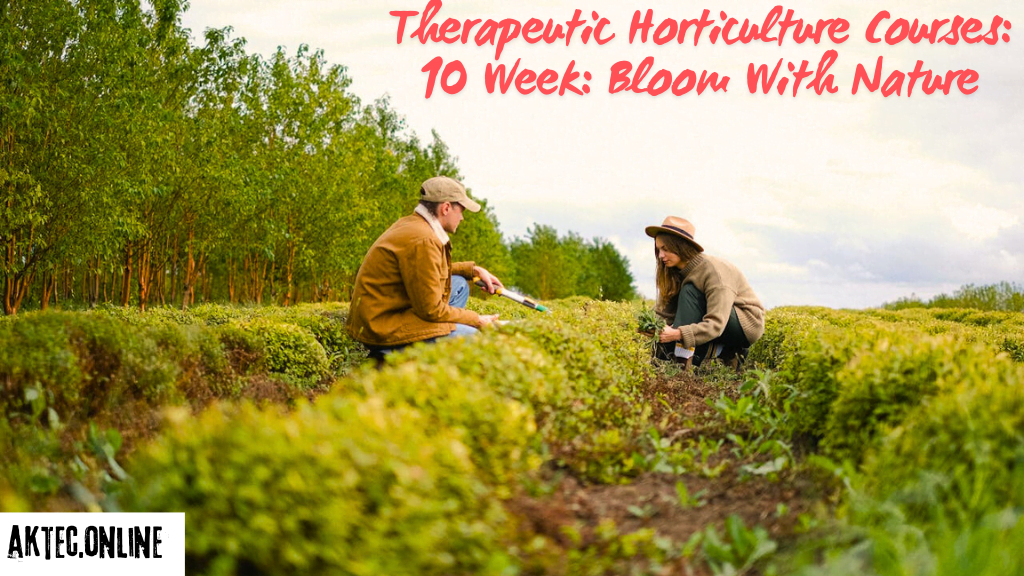
Therapeutic Horticulture in Healthcare Settings
Therapeutic horticulture programs are widely used in healthcare settings to benefit patients with various conditions. Here are some examples:
Physical Rehabilitation
Gardening activities can improve motor skills, coordination, and balance in individuals recovering from injuries or surgeries.
Mental Health Programs
Engaging with nature and plants can reduce stress, anxiety, and depression symptoms.
Cognitive Rehabilitation: Therapeutic horticulture activities can stimulate cognitive function and memory in individuals with dementia or brain injuries.
Hospice Care
Connecting with nature and participating in gentle gardening activities can provide comfort and a sense of peace for terminally ill patients.
Therapeutic Horticulture Programs for Different Populations
The beauty of therapeutic horticulture lies in its adaptability to cater to diverse populations. Here’s a glimpse into some specific applications:
Children’s Programs
Gardening activities can promote healthy development, encourage social interaction, and teach valuable life skills to children.
Programs for Older Adults
Therapeutic horticulture can improve physical fitness, cognitive function, and social engagement for older adults.
Programs for Veterans
Gardening can provide a sense of purpose, reduce stress, and promote social connection for veterans.
Evaluating Outcomes and Tracking Progress
Measuring the effectiveness of therapeutic horticulture programs is crucial for demonstrating their benefits. Here are some methods used:
Pre- and Post-Program Assessments
These assessments track changes in participants’ physical, mental, and social well-being before and after participating in the program.
Observation and Documentation
Observing participants’ engagement, behavior, and responses during activities can provide valuable insights.
Participant Feedback
Gathering feedback from participants through surveys or interviews allows for understanding their experiences and preferences.
Integrating Therapeutic Horticulture into Rehabilitation Programs
Therapeutic horticulture can be a valuable addition to various rehabilitation programs. Here’s how it can be integrated:
Occupational Therapy
Gardening activities can help individuals regain lost skills and improve their ability to perform daily tasks.
Physical Therapy
Therapeutic horticulture can be used to improve strength, coordination, and range of motion.
Speech Therapy
Gardening activities can provide opportunities for communication and social interaction, aiding speech therapy goals.
By incorporating therapeutic horticulture into rehabilitation programs, healthcare professionals can enhance the overall well-being and recovery of their patients.
Conclusion
Therapeutic horticulture offers a unique and powerful approach to improving physical, mental, and social well-being for individuals of all ages and backgrounds. By enrolling in therapeutic horticulture courses, you can gain the knowledge and skills to design, implement, and manage these beneficial gardens. Consider exploring these courses to embark on a rewarding journey of helping others connect with nature and experience the therapeutic power of plants.
FAQs
What is the difference between therapeutic horticulture and gardening?
Therapeutic horticulture goes beyond casual gardening. It utilizes plants and gardening activities in a structured way to achieve specific therapeutic goals for individuals. A qualified professional plans and facilitates these activities, tailoring them to address the participant’s unique needs.
Is a therapeutic garden different from a regular garden?
Therapeutic gardens are designed with specific features to promote accessibility, safety, and sensory stimulation for participants. They may include raised beds, wider pathways, fragrant plants, and designated seating areas to encourage interaction and relaxation.
Who can benefit from therapeutic horticulture programs?
Therapeutic horticulture caters to a wide range of individuals. It can benefit people with physical limitations, mental health conditions, cognitive impairments, or those facing social challenges. Additionally, older adults, children, and veterans can find significant improvements in their well-being through participation in these programs.
What are the different types of therapeutic horticulture activities?
Activities can vary depending on the program’s goals and participant abilities. They may include planting seeds, potting plants, weeding, harvesting vegetables, creating floral arrangements, or simply enjoying nature walks through the garden. Sensory activities like touching different plant textures or smelling fragrant herbs can also be incorporated.
How can I find therapeutic horticulture programs near me?
Many healthcare facilities, rehabilitation centers, community gardens, and senior living communities offer therapeutic horticulture programs. You can search online directories or contact local organizations related to specific health conditions to find programs suited to your needs.
